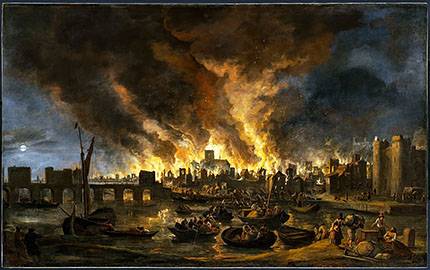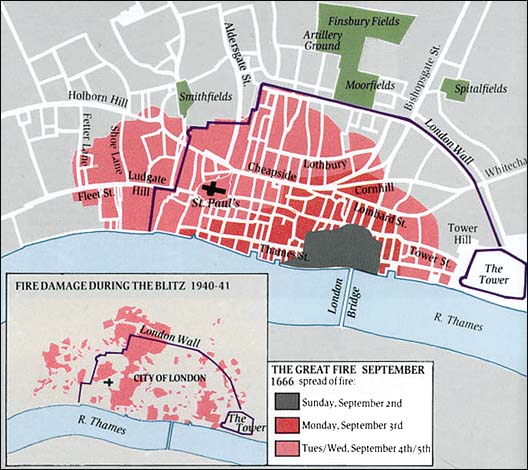The fire spread quickly since the houses of London were made of wood and pitch. The strong winds that blew that night only made things worse. Though the citizen fire brigade fought valiantly, by 8:00 A.M., the fire was halfway across the London Bridge. In fact, the only thing that stopped the fire from spreading further across the bridge was the gap that had been caused by the fire of 1633.
Back then, standard procedure for stopping fires of this nature was to create fire breaks by destroying houses in the path of the fire. Concern was raised that the cost of rebuilding might be too high, and unfortunately, the destruction of houses only pushed the fire onward. For three days, the fire burned out of control with no relief in sight until it stopped near Temple Church.
Suddenly, it began again, and now Westminster was in danger. The Duke of York ordered the Paper House to be demolished in order to create a fire break, and finally the fire was stopped once and for all.
Thankfully, the loss of life was minimal. Some sources say 16, but I think others say 6 or even 4. But this is not what staggered the city. Four hundred thirty acres--about 80% of the main part of the city--were destroyed. That includes 13,000 houses, 89 churches, and 52 Guild Halls (meeting place for craftsmen). The only positive thing about this fire was the eradication of the plague of 1665.
Before the blaze, London had very narrow streets (I cannot imagine London having more narrow streets than it does now--I have been there!). King Charles II commissioned a complete redesign of the city which included wider streets and buildings of brick. By 1671, 9000 houses and public buildings were completed. Then in 1675, work was begun on about 50 new churches. There is even a commissioned monument which still on the site of the bakery where it all began.
It would seem that the fire was an accident, but since people wanted a scapegoat, the Catholics were blamed. It was around 150 years later when the inscription that accused the Papacy of starting the fire was removed from the monument.
If you would like to see comparative pictures of the London skyline before and after the fire, click here.
Websites Used:
- http://www.luminarium.org/encyclopedia/greatfire.htm
- http://www.bbc.co.uk/history/british/civil_war_revolution/great_fire_01.shtml




0 comments:
Post a Comment